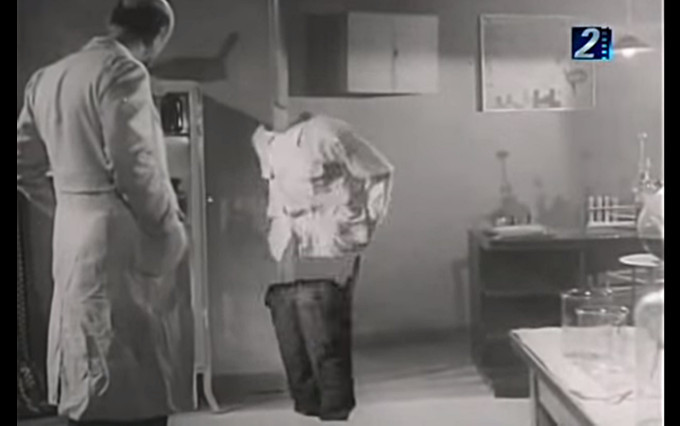
A scientist’s assistant turns himself invisible as to win the hand of his beloved. Egypt’s first SF movie from 1952 is a light-hearted musical comedy inspired by Universal’s Invisible Man films. Not very original, but aptly made and quite enjoyable. 5/10
Min aina laka haza? 1952, Egypt. Directed by Niazi Mostafa. Written by Ali El Zorkani & Muhammad Fawzi. Starring: Muhammad Fawzi, Madiha Yousri, Farid Shawqi, Ismail Yasseen, Hassan el Baroudi, Zeenat Sidqi. Produced by Muhammad Fawzi. IMDb: 5.8/10. Rotten Tomatoes: N/A. Metacritic: N/A.

This is a rare entry on this blog of Arabic science fiction, which is certainly not a huge subgenre, but nevertheless not to be overlooked. As a prosperous, stable and fairly secular country, Egypt was long the dominant film producer of the Arab countries and the golden age of Egyptian cinema lasted from the forties to the sixties. To a modern viewer, the liberal take on violence and sex in of some of the genre films of the golden age is surprising. Min aina laka haza? (“Where Did You Get This?”) is in comparison a rather timid little film, and like much of the genre cinema of Egypt in the day, it was a blatant ripoff Hollywood’s genre films, in this case the Invisible Man franchise by Universal.
Although largely marginalised today, like much of Middle-Eastern cinema, in its heyday Egypt’s movie industry was a powerhouse on par with Hollywood. Egypt was the dominating cinema in Middle-Eastern and Arab countries, and its movie stars were known all over the region, some of them, like Omar Sharif, reaching a Western audience. Egypt was also where actors and music artists of the rest of the region went in search of stardom.
The dominating genre was the musical, in part because Egyptian singers were already famous in most of the Middle-East through radio, but also because people not used to Egyptian Arabic could enjoy the songs even if they couldn’t follow all the dialogue. But genre cinema also found an audience, especially in the cheap so-called Third Class cinemas, where comedies and action films went down well. As stated above, most genre pieces of the time were cheap Hollywood ripoffs, especially of Universal creature features, which were the genre films most frequently imported to Egyptian movie theatres.
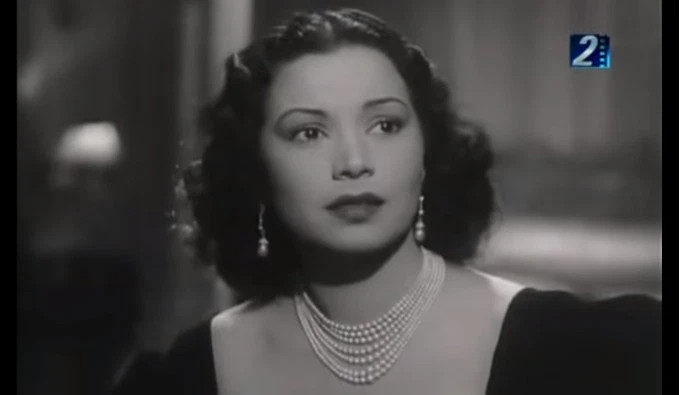
Among the first Egyptian genre films (excluding some Arabian Nights-styled fantasies) were Husain Fawzi’s Tarzan/gorilla film Nadouga (1944) and Niazi Mostafa’s The Vanising Cap (Taqiat ul-ikhfa, 1944). Mostafa was a huge fan of Universal visual effects wizard John P. Fulton’s invisibility effects, and studied the techniques closely and first put them to use in The Vanishing Cap, and Return of the Vanishing Cap (1946), two films which he remade in 1959 as The Secret of the Vanishing Cap. But these were more fantasy than sci-fi. A few directors like Hasan Ramzi also turned out a few demon and genie horror films in the late forties but it really wasn’t until the fifties that the horror genre established itself – and still mostly combined with comedy (not unlike some Universal efforts).
The first bona fide science fiction film of Egypt saw the light of day in 1952 when Niazi Mostafa finally got around to make his own The Invisible Man (1933, review) flick, Min aina laka haza?
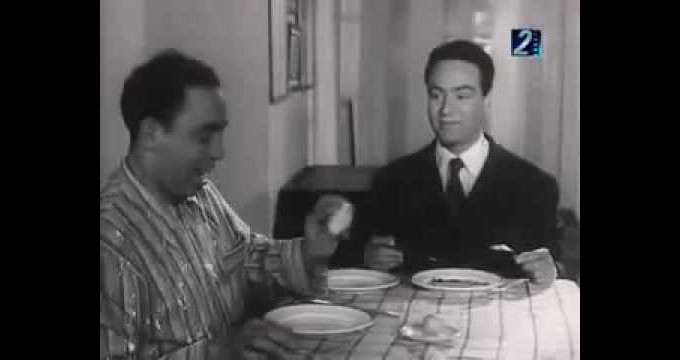
The plot of the film is simple and derivative enough that it can be followed and even enjoyed without subtitles with the help of a short synopsis. It follows a young medical student (Muhammad Fawzi) who is helping his professor perfect an invisibility serum alongside his valet (Ismail Yasseen). They secretly try it out on a dog that has been brought for treatment – and it works! After returning the dog to its natural state, the student brings it back to the owner, the beautiful Salwa (Madiha Yousri), daughter of a rich nobleman. And the two immediately fall in love – after the valet has a bout of wrestling with the housekeeper (Zeenat Sidqi).
Unfortunately Salwa’s father has already promised his daughter’s hand in marriage to another suitor, a brutish casino owner (Farid Shawqi). The student and Salwa meet in secret, the student breaks out in song a few times, but when the casino owner’s lackeys find out about the affair, they cook up a plot to accuse the student of kidnapping Salwa, setting the police on him. The student then uses the invisibility serum on himself to escape the bluebells and dig up dirt on the casino owner. He discovers that the brute is also a drug kingpin and after becoming visible again fools the police into following him straight to the other suitor’s drug lair, where the valet in turn takes the invisibility serum when a gunfight breaks out, and hilarity ensues. Yes, this is a musical comedy, in case I forgot to mention it. All’s well that ends well, except for the valet, who can’t turn visible again and turns up for Salwa’s and the student’s wedding all bandaged up and in sunglasses, in a nod to James Whale’s original invisible man film.
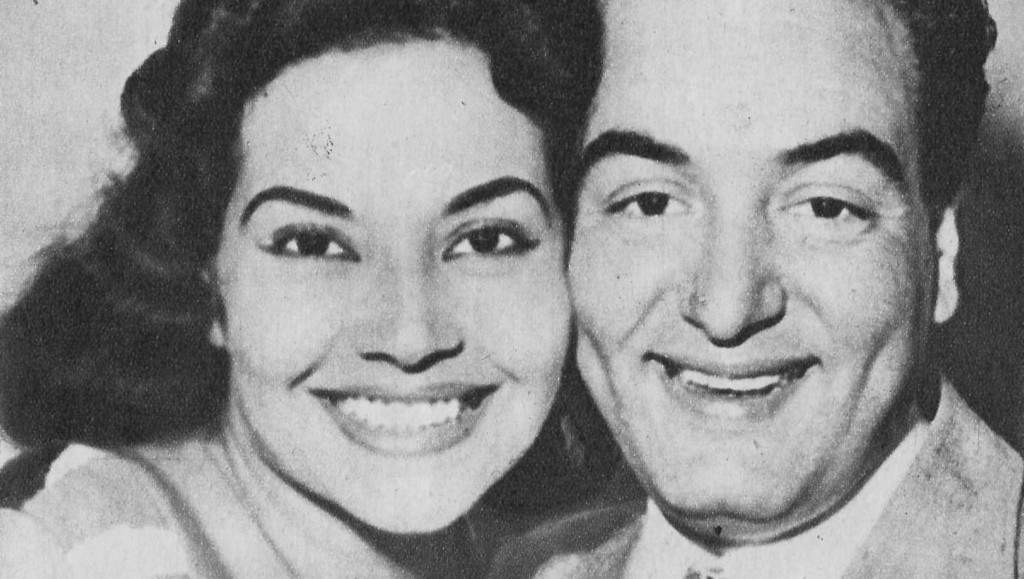
The film is something of a who’s who? of Egyptian B movies of the fifties. Lead actor Muhammad Fawzi was one of Egypt’s most popular singers and songwriters of the late forties and early fifties. A bit like Elvis, though, he didn’t quite have the acting or dancing chops to make it like Frank Sinatra or Gene Kelly, but was able to breeze through musical romcoms on fame, charisma and cuteness alone. Indeed, to keep a steady roll of films coming his way he founded his own film company, the originally named Film Company Muhammad Fawzi, and thus worked as producer on Min aina laka haza? Not only did he produce and act, he is also credited for coming up with the story of the film, as well as for composing all the songs of the movie, as well as some of the soundtrack – where it is not borrowed from Universal’s invisible man films. Fawzi did, however have stints in A movies, like Daiman Maak, a classic romantic comedy starring Egypt’s biggest female movie star Faten Hamama.
The valet – Ismail Yasseen (sometimes spelled Yassine, I’m going with IMDb’s spelling) was the king of B comedies. Yasseen turned up in a whole slew of genre comedies in the vein of Abbott & Costello. Some of his most successful films bore names like Ismail Yasseen in the Mental Hospital and Ismail Yasseen in the Navy. In 1951 he starred in The Haunted House, in 1954 in Ismail Yasseen and the Ghost and Ismail and Abdel Meet Frankenstein, in 1958 in Ismail Yasseen as Tarzan and in 1959 he starred in the rare Egyptian space film Journey to the Moon. Yasseen steals all shots he is in with his wide-eyed comedy, not unlike the sort of jittery shtick that Mantan Moreland was doing in the States in the previous decade. Yasseen’s wide grin and over-the-top facial expressions coupled with plasticity and slapstick sensibilities makes him something of a proto-Eddie Murphy, or perhaps an Egyptian Jerry Lewis. At least for someone who doesn’t speak Arabic, Yasseen is reason enough to watch the movie.
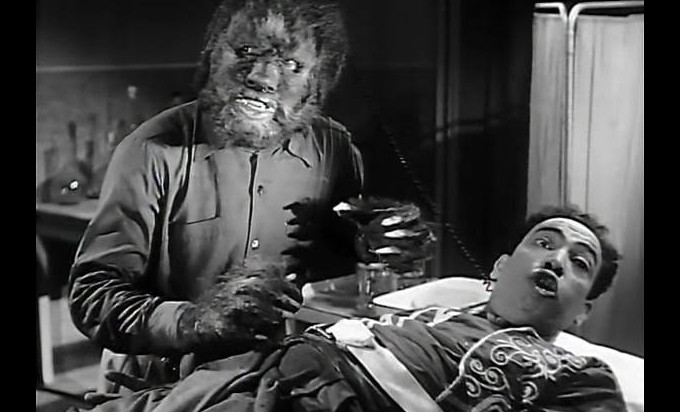
But the biggest star of the film is Farid Shawqi, officially named the king of Third Class cinema, best known as the Beast – a title like John Wayne’s the Duke, portraying his immense popularity among the lower classes of Egypt in the fifties and sixties. Shawqi at this point still hadn’t reached the peak of his success and was still typecast in villainous roles, but he would later become known as the ultimate strongman hero who smashed the bad guys and saved the day. So beloved was he, that even in films in which he didn’t appear, the audience would call out for the Beast to turn up and take care of business. Even though he was sometimes called the Anthony Quinn of Egypt because of his resemblance to the American actor, he would be more suited as the John Wayne of Arabic-language pictures. He appeared in over 300 movies in his long career, not all of them of top quality. However some of his films are highly regarded classics of Egyptian cinema, like Salah Abouseif’s The Beginning and the End (Bidaya wa nihaya, 1961, also known as Dead Among the Living), in which he starred opposite Omar Sharif. He was also the star of one of the best known Egyptian films of all times, Cairo Station or The Iron Gate (Bab el hadid, 1958), directed by the legendary Youssef Chahine. The film was nominated for a Golden Bear at the Berlin Film Festival. Another Chahine-Shawqi collaboration was Alexandria… Why? (Iskanderia… lih?, 1979), which won the Silver Bear and was nominated for the Golden Bear and won the prize for best film at the Chicago Film Festival. Their collaboration Struggle in the Valley (Siraa Fil-Wadi, 1954) was nominated for the Palm d’Or at the Cannes Film Festival, and starred Shawqi, Sharif and Hamama.

Female star Madiha Yousri was never quite as iconic a seductress as Shadia, Hind Rostom (the Marilyn Monroe of Egypt) or Faten Hamama, but was nevertheless one of the great stars of Egypt’s cinema in the forties and fifties, and went on to become one of the most respected women in the movie business as producer and champion of women’s rights in the industry. Yousri’s career spanned over 70 years, the longest of any actress in Egypt, rivalled only by Hamama. She bowed out of the business in 2012 and passed away shortly after. She was also known for her many husbands – at the time of Min aina laka haza? she was married to star and producer Muhammad Fawzi.
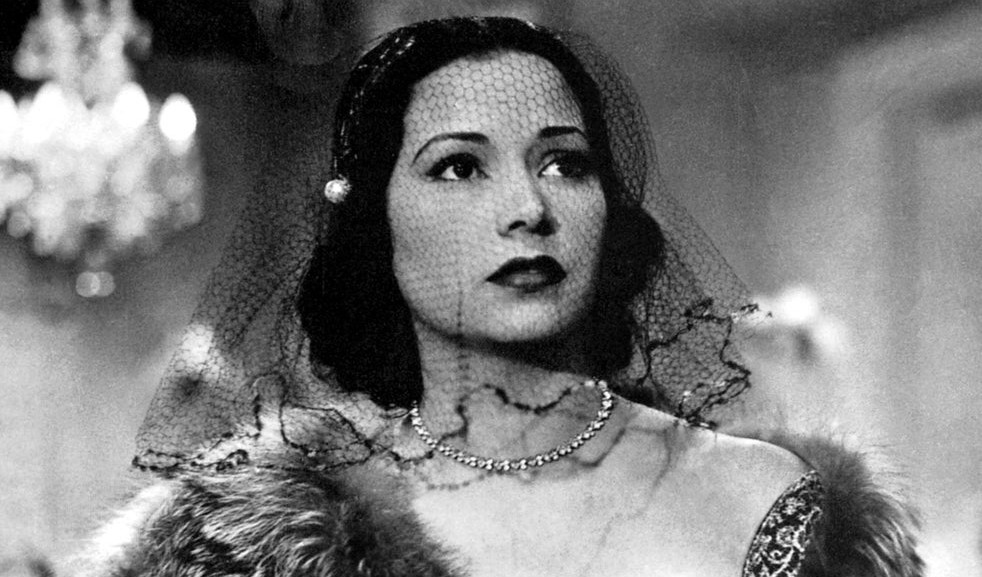
Named ”one of the most important directors of Egypt”, Niazi Mostafa specialised in comedy, special effect films and action after studying cinema in Germany for three years. He was seen as one of the great special effects innovators in Egypt, and concentrated mostly on B movies and musical comedies, although some of his films rank among the best in Egyptian cinema history, like Everything is Fine (1938) and A Glass and a Cigarrette (1955). Mostafa kept on working up until 1986, when he was brutally murdered in his apartment by unknown assailants. Apart from his love for invisibility effects, Mostafa was also a huge fan of another Hollywood genre – the ape movie, and he used ape suits in a number of films, including Min aina laka haza?
Despite Universal’s ripoff claims, Min aina laka haza? has almost nothing in common with H.G. Wells‘ 1897 novel The Invisible Man, nor does it really follow any of the plots of Universal’s later films in the series. However, many of the action sequences do feel almost like remakes of The Invisible Man. Fawzi even lets out a Claude Rains-like howling laughter when he first becomes invisible, and the scene where he first takes off his trousers and his white shirt looks eerily familiar – he also careens through a nightclub causing mayhem much like Rains’ character caused an uproar in the small English town, just for kicks, in the original film. There’s also a clear homage in the last scene of the film, where Yasseen’s character is stuck in invisibility mode at the wedding between the two leads – decked out in bandages and sunglasses, which are removed by the housekeeper in the very last shot of the movie. But story-wise, the film does stand – more or less – on its own legs.
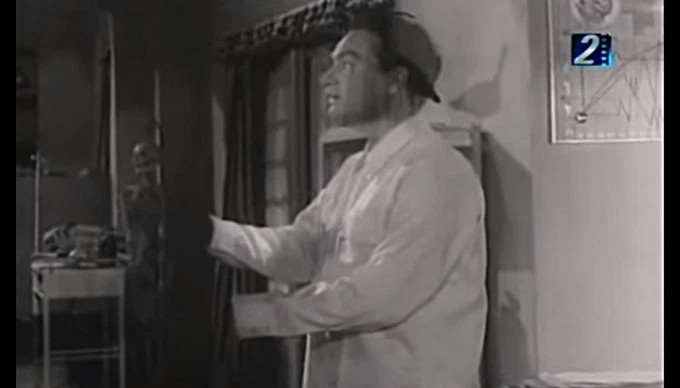
Mostafa’s handling of the invisibility scenes is almost seamless – the undressing is better than what Fulton pulled off in the original film in 1933, but of course Mostafa had the luxury of learning from 20 years of cinematic evolution. There’s a blatant mistake at one point when Fawzi is downing a glass of smoking serum and you can see the smoke disappearing abruptly in mid-air, as the actor is standing behind a bluescreen (or probably blackscreen at the time). The stop-frame process of Yasseen turning into an ape is very clumsily done, and the ape suit itself is appallingly bad. Rear projection in car driving scenes is also much too blurry to be realistic.
The direction itself is professional and steady, if a bit workmanlike, and there is nothing to distinguish it for better or worse from Hollywood productions of the same sort. At an hour and 48 minutes the movie is on the longer side and would have benefited from some editing – it would probably have lost very little of importance if it had been cut down to standard Hollywood B movie length of an hour. However, it is thoroughly enjoyable, the music of Fawzi is occasionally beautiful, the acting good and the comedy often quite funny even without the dialogue. That I could follow the story so easily without the dialogue does say something about the originality, though, and probably about the quality of said dialogue.

Neither IMDb nor Arabic Wikipedia has much info on the film (save that which I have submitted), and what I know I have been able to scrape together from various Arabic-language sources, often containing very scarce information, with the help of Google Translate.
Janne Wass
Min aina laka haza? 1952, Egypt. Directed by Niazi Mostafa. Written by Ali El Zorkani and Muhammad Fawzi. Starring: Muhammad Fawzi, Madiha Yousri, Farid Shawqi, Ismail Yasseen, Hassan el Baroudi, Zeenat Sidqi, Abdel Salam Al Nabulsy, Edmond Tuima, Riad Aglosbjee, Kitty, Abdalbagi Hassanein, Anwar Zaki, Mohammed Abu Saud, Rashad Hamid, Ismail Tawab, Ahmed Bali. Music: Muhammad Fawzi. Cinematography: Muhammad Tahir. Art direction: Robert Scharfenberg. Makeup: Mahmoud Samaha.Visual effects: Niazi Mostafa. Produced by Muhammad Fawzi for Film Company Muhammad Fawzi.

Leave a comment